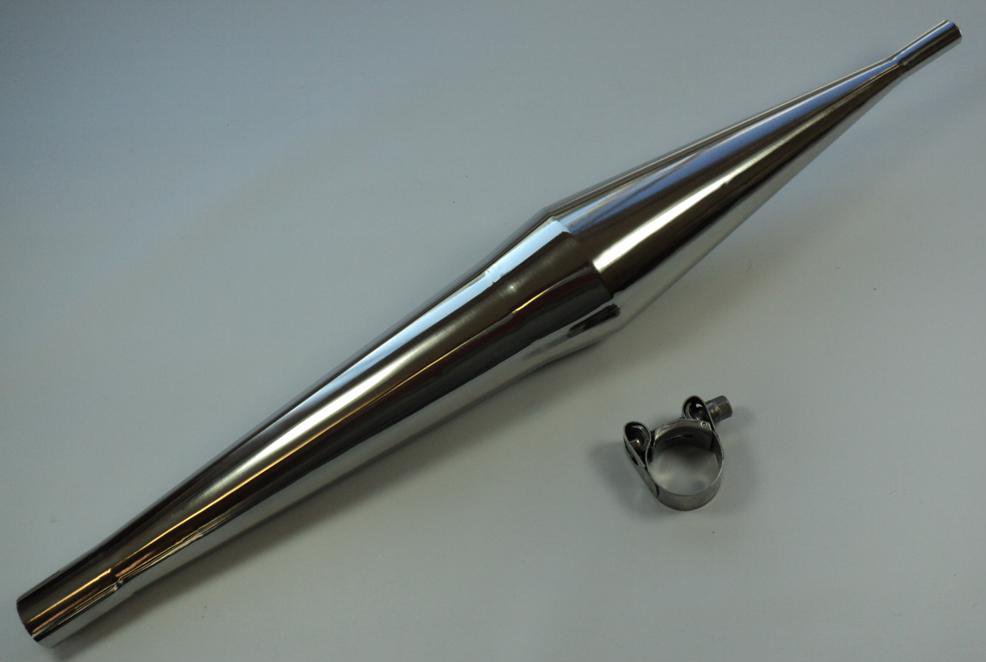The Zipp Super Tuned Pipe was designed to provide a long, flat torque curve so that you can pull a wide variety of props, and stay in a usable RPM range.
This pipe is one of the most powerful tuned pipes you can buy and is easy to tune, as long as you understand what you are doing.
There are many good web pages that describe exactly how tuned pipes work, but the only thing you have to know is that they use sound waves to force the fuel/air mixture back into the cylinder before the piston closes the port.
If the pipe is too long or too short, the cylinder will not get the full charge and you won’t see a big gain in power, as tuned pipes are 2 stroke superchargers.
We want the pipe to be the correct length so that your engine “comes on the pipe” or “hits” at the proper RPM.
Stock and modified engines have different starting lengths. 14 inches for a stock engine, and 13.5 inches for a modified engine.
Set the pipe at exactly 13.5 (or 14) inches from the face of the exhaust port to the largest part of the tuned pipe. Be sure to measure along the centerline of the header, around the bend.
The easiest way to do this is to make a piece of stiff wire that is 13.5 inches long.
Bend it to match the header like the red line below.
Measure from the face of the exhaust port, to the maximum pipe diameter.
Cut excess header so that there is 1-1/2 inches of header inside the pipe (at 13.5 inches).
With a stock engine, you can’t really feel the pipe “hit”, so you have to test.
With the pipe at 14, try different props until you find one that the boat likes.
Use a radar gun or GPS for comparison. This may not be the fastest MPH prop, but one that runs smooth without hopping, and allows the boat to turn well.
Once you find a good prop and have a baseline MPH, start adjusting the pipe in 1/8 inch increments.
This is necessary to zero in on the best setting.
Pull the pipe in to 13-7/8 inch and run the boat. If you pick up speed, pull it in another 1/8 inch.
Do this until the speed flattens out or you start losing power coming out of the corners.
Moving the pipe 1/8 inch moves the peak power band by 500 RPM.
Don’t misunderstand that last statement.
If your boat is propped so that the engine makes best power at 14000 RPM and the pipe is peaking at 14,500, you will get an increase in power by pulling the pipe out 1/8 inch.
Think of the engine power band and pipe power bands as two separate graphs.
The engine power band stays the same (with that prop) but the pipe power band is adjustable.
You want to adjust the pipe so that they are the same. This is called in resonance. The way to do that with a stock engine is to test, measure and adjust.
There is no way that you can get maximum performance by setting your pipe at one length and not testing.
With a modified engine, it is quite easy, as our pipe “hits” pretty hard.
Same approach. Set the pipe at 13.5 inches. Run different props and find one that you like.
Run the boat and try to determine when the pipe “hits” If you pay attention, you can see, hear and feel when the pipe hits. It is like a little shot of nitrous.
With the boat on plane, very slowly open the throttle.
You will find a point that the engine seems to just jump in power. Do this several times and try to remember where the throttle is when this happens.
If the pipe is long, this will happen below half throttle. If short, you will never feel it at all.
Let’s say that you have a modified engine, and it never hits the pipe.
Pull it out ¼ inch and try again.
What we want to do is make the pipe hit at ¾ throttle or slightly higher.
I like to set it for ¾ throttle so that there is “headroom” for large air temperature changes.
If the weather changes a bunch, you will notice that the pipe hits at a slightly different point.
If you adjust it to hit at full throttle and the next race is 20 degrees warmer, it may never hit.
In summary, the only way to get peak performance out of your boat is to make sure everything is setup to work with everything else. Pipe, prop, engine, hull setup, etc.
What we learned:
With a given load (prop) the engine’s power band is the same.
The pipe has an adjustable power band.
When these two align, the pipe is in resonance and is supercharging to full effect.
Remember, pipe for the prop.
I have a question for you. With what you learned, how do you tune a boat with a fixed pipe length?
Email the answer to us.
Copyright © 2025 Zipp Manufacturing
This article was written by Joe Petro for the Zippkits Super Tuned Pipe designed by Joe Petro.
If you reprint this article in part or whole, please include this credit.



